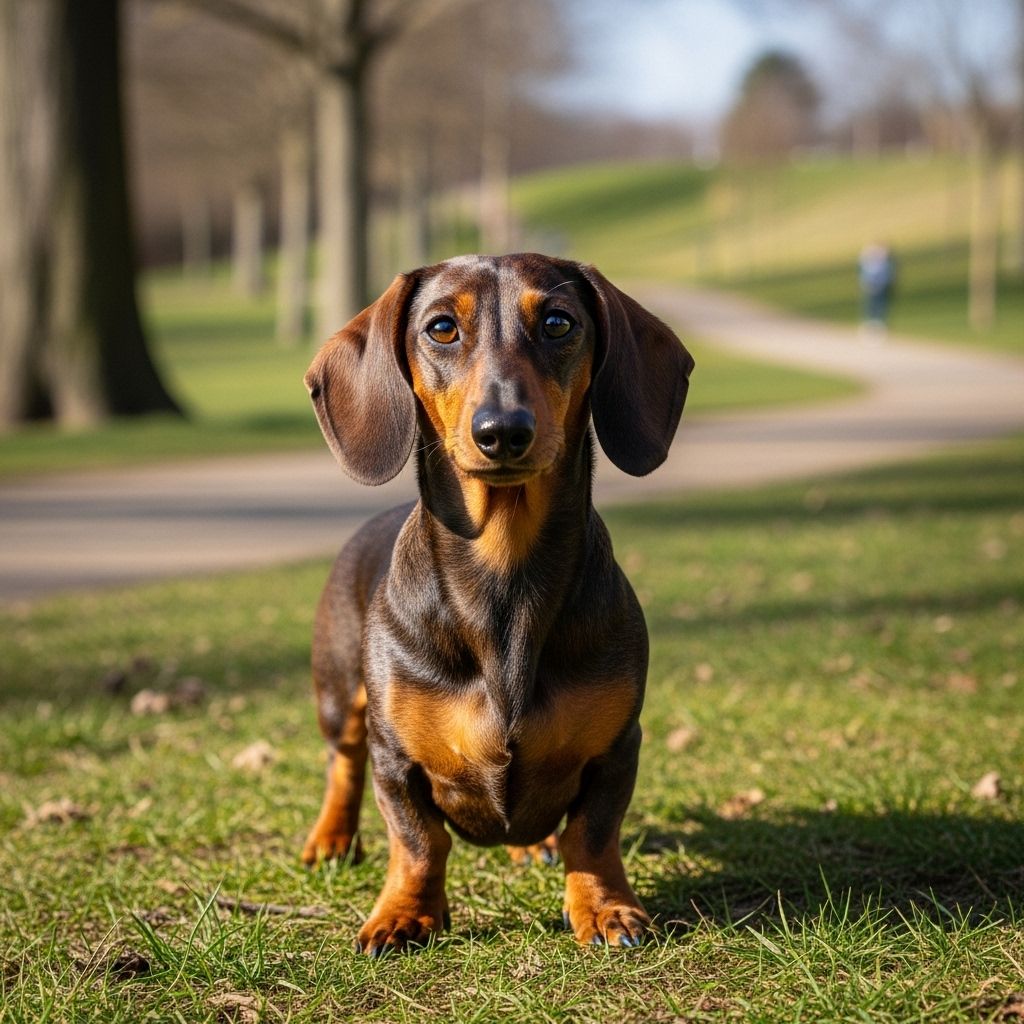Dachshund Dog Breed: Complete Guide To Care, Training & Health
Small canine with big personality, bringing joy and unwavering devotion daily.

Image: HearthJunction Design Team
Dachshund: The Lively, Loyal, and Endearing ‘Wiener Dog’
The Dachshund, affectionately known as the Doxie, Wiener Dog, or Sausage Dog, is one of the most distinctive and beloved dog breeds in the world. Renowned for their elongated bodies and spirited personalities, Dachshunds are more than just a cute face—they are intelligent, courageous, and endlessly loyal companions with a fascinating history and unique physical traits.
Breed Overview
- Group: Hound
- Origin: Germany
- Size: Standard (16–32 lbs), Miniature (<11 lbs)
- Coat Types: Smooth, Longhaired, Wirehaired
- Life Span: 12–16 years
- Temperament: Lively, brave, affectionate, stubborn
History and Origins
The Dachshund’s roots trace back to 15th century Germany, but it was in the 17th century that the breed truly began to evolve into what we know today. The name “Dachshund” translates directly to “badger dog”—a testament to their original purpose. Bred with the courage and tenacity to hunt badgers, their distinctive elongated bodies, short legs, and powerful chests perfectly suited them for digging and maneuvering through underground tunnels to flush out prey.
Over time, breeders developed two primary sizes for specific hunting purposes.
- Standard Dachshunds: Bred to hunt larger prey like badgers and wild boar.
- Miniature Dachshunds: Smaller, agile hunters for rabbits and foxes.
In Germany, a third, intermediate size exists, reflecting the breed’s adaptability and versatility in the field. Their keen senses and stubborn determination have made them a favorite of royalty and artists, including Queen Victoria and Pablo Picasso, whose Dachshund, Lump, was immortalized in several works.
Physical Characteristics
| Feature | Miniature | Standard |
|---|---|---|
| Height | 5–6 inches (13–15 cm) | 8–9 inches (20–23 cm) |
| Weight | Up to 11 lbs (5 kg) | 16–32 lbs (7–15 kg) |
| Coat Types | Smooth, Longhaired, Wirehaired | |
| Typical Color | Reddish brown, black-and-tan, among many others | |
| Body Type | Long body, short legs, deep chest, long muzzle, floppy ears | |
Dachshunds are instantly recognizable. Their muscular build and low-to-the-ground posture are not only charming but also the result of centuries of selective breeding for hunting prowess. Their floppy ears help keep dirt and debris out while digging, and their expressive eyes radiate intelligence and curiosity.
Coat Types and Colors
- Smooth: Sleek, shiny, and low-maintenance. The classic look most associated with Dachshunds.
- Longhaired: Elegant, flowing coat requiring regular grooming to prevent mats and tangles.
- Wirehaired: Dense, coarse outer coat with bushy eyebrows and beard; needs routine trimming and brushing.
Dachshunds come in a wide array of colors and patterns, including single and bi-color combinations like red, cream, black-and-tan, chocolate, dapple, piebald, and more, making each Doxie unique in appearance.
Personality and Temperament
Dachshunds are renowned for their larger-than-life personalities packed into a small frame. Here are some hallmark temperament traits:
- Brave and Bold: Originally bred for hunting fierce prey, they display surprising courage and fearlessness.
- Loyal: Dachshunds form deep bonds with their families and can be extremely devoted.
- Playful and Energetic: They love games, toys, and anything that challenges their minds and bodies.
- Independent (and Stubborn): Their hunting heritage makes them independent thinkers, which can manifest as stubbornness during training.
- Alert and Vocal: Dachshunds make excellent watchdogs, quick to announce new arrivals or strange noises with their distinctive bark.
They thrive best with families who understand their need for mental and physical stimulation. Properly socialized, they can get along well with other dogs and children, but their boldness may lead them to challenge much larger animals.
Living Needs
- Space: Dachshunds adapt well to both apartment and house living but always need regular opportunities for exercise.
- Exercise: Daily walks and playtime are crucial to prevent boredom and the development of undesirable behaviors.
- Companionship: These dogs do best in homes where they have company for most of the day and may develop separation anxiety if left alone for extended periods.
- Safety: Given their propensity for back problems, homes should be adapted to prevent jumping on/off high surfaces (consider ramps or steps).
While adaptable, Dachshunds are not content to be idle lap dogs and will find ways to entertain themselves—sometimes to their owners’ dismay if not given appropriate outlets!
Training and Socialization
Training a Dachshund can be both rewarding and challenging. Their intelligence is matched by an independent streak, so patience and positive reinforcement are key.
- Early Socialization: Expose your Dachshund to various people, animals, and environments from a young age to foster confidence and reduce shyness or aggression.
- Consistent Training: Use reward-based methods. Harsh corrections can lead to resistance or fearfulness.
- Housebreaking: Dachshunds may take longer to fully house train compared to some breeds, but consistency and routine help.
- Mental Stimulation: Puzzle toys, scent games, and obedience exercises are excellent outlets for their minds.
Because of their hunting background, Dachshunds may have a strong prey drive. Secure fencing is a must, and off-leash play should be carefully managed.
Common Health Problems
While generally robust, Dachshunds are predisposed to certain health issues, primarily related to their long backs:
- Intervertebral Disc Disease (IVDD): A common hereditary condition where the discs in the spine can herniate, causing pain, nerve problems, or even paralysis. Preventive measures include maintaining a healthy weight and restricting excessive jumping.
See: 7 Ways to Treat and Prevent Back Problems in Dachshunds - Obesity: Their small stature makes them susceptible to rapid weight gain, which exacerbates back and joint issues.
- Dental Problems: Dachshunds are prone to periodontal disease and require regular dental care.
- Patellar Luxation: The kneecap can slip out of place, causing pain and lameness.
- Progressive Retinal Atrophy: A hereditary condition leading to vision loss.
- Heart Disease: Can occur, particularly as Dachshunds age.
Regular veterinary checkups, weight management, and tailored exercise routines are the best ways to keep a Dachshund healthy and happy.
Grooming and Care
Grooming needs vary by coat type:
- Smooth: Weekly brushing to remove loose hair and dirt; quick wipe-downs keep the coat shiny.
- Longhaired: Brush several times a week to prevent mats and keep the coat looking its best.
- Wirehaired: Needs regular brushing plus occasional hand-stripping to maintain coat texture.
All Dachshunds require:
- Regular nail trimming
- Dental care (brushing teeth several times per week)
- Ear cleaning, especially for those with floppy ears prone to infections
Exercise Requirements
Despite their size, Dachshunds are energetic little athletes and require daily activity to keep mind and body fit. Sufficient exercise helps prevent weight gain and provides much-needed mental stimulation.
- Daily walks (1-2 per day, adjusted by age/health)
- Play sessions: fetch, scent games, tug-of-war
- Avoid high-impact activity (jumping from heights) to protect their spine
Diet and Nutrition
A balanced diet is crucial for a Dachshund’s longevity and well-being. Since they are prone to obesity, measure portions carefully and limit treats.
- Feed a high-quality, age-appropriate commercial or vet-approved homemade diet
- Monitor weight regularly; adjust portions as needed
- Divide food into two or more meals per day to help prevent bloat
Always consult with your veterinarian to determine the best dietary plan for your individual dog.
Is the Dachshund the Right Dog for You?
Dachshunds make wonderful companions for those who appreciate their lively spirit and are prepared to meet their physical and mental needs. They do best in homes where they are true members of the family and are not left alone for long stretches.
- Pros: Affectionate, loyal, entertaining, adaptable, minimal grooming (smooth coat)
- Cons: Can be stubborn, prone to barking, sensitive to rough handling (not ideal for very young children), require vigilance regarding back safety
With the right care, training, and environment, a Dachshund can bring years of joy, laughter, and adventure into your life.
Frequently Asked Questions (FAQs)
How long do Dachshunds live?
With proper care, Dachshunds typically live 12–16 years.
Are Dachshunds good with children?
Dachshunds can be great companions for respectful, older children. They may not tolerate rough or careless handling. Early socialization is key.
Do Dachshunds get along with other pets?
Well-socialized Dachshunds can get along with other dogs and pets, though their hunting drive may lead to chasing smaller animals.
How much exercise does a Dachshund need?
Dachshunds require at least 30–60 minutes of daily exercise, divided between walks and playtime, to stay healthy and prevent boredom.
What health issues are common in Dachshunds?
The breed is most prone to back issues such as Intervertebral Disc Disease (IVDD), as well as obesity, dental disease, and eye problems.
Are Dachshunds easy to train?
While intelligent, Dachshunds can be stubborn. Positive reinforcement and patience are essential for successful training.
Quick Tips for New Dachshund Owners
- Use ramps or steps to help your Dachshund on and off furniture
- Supervise interactions with children and larger pets
- Maintain a healthy weight to protect their spine
- Engage them with toys, puzzles, and training exercises
- Schedule regular veterinary checkups
Conclusion
The Dachshund is a breed unlike any other—bold, loving, and full of character. With the proper care, training, and attention, this “badger dog” can become a cherished companion and lively family member for many years. Whether you’re drawn by their unique look or their spirited personality, the Dachshund is sure to leave an indelible mark on your life.
References
Read full bio of Shinta












